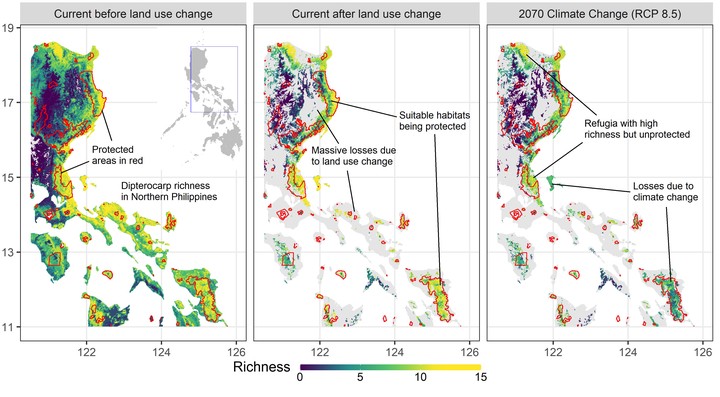Effects of climate change and land cover on the distributions of a critical tree family in the Philippines
 Model prediction of Dipterocarpaceae richness in Luzon, Philippines for 19 dipterocarps. Left: the initial model output showing total species richness based on climate suitability only. Middle: the predicted species richness when removing deforested areas. Right: Projections of species richness in the year 2070, considering only forested areas. Red polygons show the current protected area network. The figure shows huge losses of dipterocarp ranges owing to deforestation and that much of the most species-rich areas projected in 2070 remain outside of the current protected area network.
Model prediction of Dipterocarpaceae richness in Luzon, Philippines for 19 dipterocarps. Left: the initial model output showing total species richness based on climate suitability only. Middle: the predicted species richness when removing deforested areas. Right: Projections of species richness in the year 2070, considering only forested areas. Red polygons show the current protected area network. The figure shows huge losses of dipterocarp ranges owing to deforestation and that much of the most species-rich areas projected in 2070 remain outside of the current protected area network.
Abstract
Southeast Asian forests are dominated by the tree family Dipterocarpaceae, whose abundance and diversity are key to maintaining the structure and function of tropical forests. Like most biodiversity, dipterocarps are threatened by deforestation and climate change, so it is crucial to understand the potential impacts of these threats on current and future dipterocarp distributions. We developed species distribution models (SDMs) for 19 species of dipterocarps in the Philippines, which were projected onto current and two 2070 representative concentration pathway (RCP) climate scenarios, RCP 4.5 and 8.5. Current land cover was incorporated as a post-hoc correction to restrict projections onto intact habitats. Land cover correction alone reduced current species distributions by a median 67%, and within protected areas by 37%. After land cover correction, climate change reduced distributions by a median 16% (RCP 4.5) and 27% (RCP 8.5) at the national level, with similar losses in protected areas. There was a detectable upward elevation shift of species distributions, consisting of suitable habitat losses below 300 m and gains above 600 m. Species-rich stable areas of continued habitat suitability (i.e., climate macrorefugia) fell largely outside current delineations of protected areas, indicating a need to improve protected area planning. This study highlights how SDMs can provide projections that can inform protected area planning in the tropics.